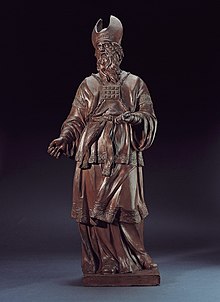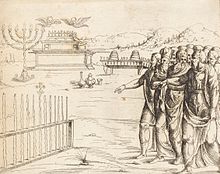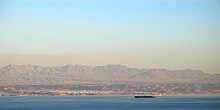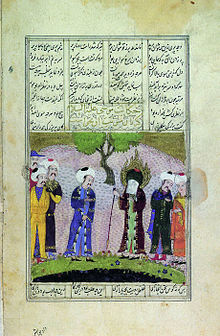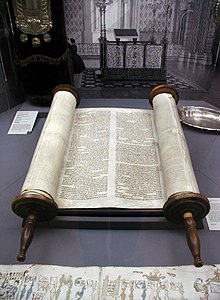Jesus in Islam
 Jesus in Islam
Jesus in Islam
In Islam, ʿĪsā ibn Maryam (Arabic: عِيسَى ٱبْنُ مَرْيَمَ, lit. 'Jesus, son of Mary'), or Jesus, is understood to be the penultimate prophet and messenger of God (Allah) and the Messiah, sent to guide the Children of Israel with a new revelation: Injīl (Arabic for "the gospel").[1][2][3]
As in the Christian New Testament, the Quran (the central religious text of Islam) describes Jesus as the Messiah (al-Masih in Arabic), born of a virgin, performing miracles, accompanied by disciples, rejected by the Jewish establishment, and being raised to heaven.[4] The Quran differs in denying Jesus was crucified or died on the cross, and especially in rejecting the divinity of Jesus as God incarnate, or the Son of God.[4][a]
The significance of Jesus in Islam is reflected in his being mentioned in the Quran in 93 verses with various titles attached such as "Son of Mary" and other relational terms, mentioned directly and indirectly, over 187 times.[2][6][7][8][8][9] He is thus the most mentioned person in the Quran by reference; 25 times by the name Isa, third-person 48 times, first-person 35 times, and the rest as titles and attributes.[note 1][note 2][10][note 3][11]
The Quran and most hadiths (testimonial reports) mention Jesus to have been born a "pure boy" (without sin) to Mary (مريم) as the result of virginal conception, similar to the event of the Annunciation in Christianity.[2][12][13] The Quran denies Jesus is the son of God in several verses, including one (Q.5:116) quoting Jesus as denying he is the son of God.[4] According to mainstream Islamic interpretations of the Quran, he was neither crucified nor raised from the dead, but rather was saved by God.[14] (Although the earliest Islamic traditions and exegesis quote somewhat conflicting reports regarding a death and its length, most Muslims believe that Jesus only appeared to be crucified and was instead raised alive to heaven).[15][16] In Islam, Jesus is believed to have been the precursor to the Islamic prophet Muhammad, attributing the name Ahmad to someone who would follow him. He is believed to have performed many miracles, several being mentioned in the Quran.[17][18] Over the centuries, Muslim writers have referenced other miracles like casting out demons, having borrowed from some heretical pre-Islamic sources, and from canonical sources as legends about Jesus were expanded.[18] Like all prophets in Islam, Jesus is also called a Muslim, as he preached that his followers should adopt the "straight path". In Islamic eschatology, Jesus returns in a Second Coming to fight the Al-Masih ad-Dajjal or "False Messiah" and establish peace on earth.
Birth of Jesus
Jesus' lineage, going back to his great-grandfather
Main article: Nativity of Jesus
See also: Maryam (surah) and Mary in Islam
The account of Jesus begins with a prologue narrated several times in the Quran first describing the birth of his mother, Mary, and her service in the Jerusalem temple, while under the care of the prophet and priest Zechariah, who was to be the father of John the Baptist. The birth narrative in the Quran for Jesus begins at Maryam (19) 16-34 and al-Imran (3) 45-53.[19] The birth narrative has been recounted with certain variations and detailed additions by Islamic historians over the centuries.
While Islamic theology affirms Mary as a pure vessel regarding the virgin birth of Jesus, it does not follow the concept of Immaculate Conception as related to Mary's birth in some Christian traditions.[20]
Annunciation
See also: Annunciation
Islamic exegesis affirms the virginal birth of Jesus similarly to the Gospel account and occurring in Bethlehem.[21] The narrative of the virgin birth is an announcement to Mary by the angel Gabriel while Mary is being raised in the Temple after having been pledged to God by her mother. Gabriel states she is honored over all women of all nations and has brought her glad tidings of a holy son.[22]
A hadith narrated by Abu Hurairah (d. 681), an early companion of the Prophet, quotes Muhammad explaining that both Jesus and Mary were protected from Satan's touch at birth; a quoting of Al Imran 3:36.[23]
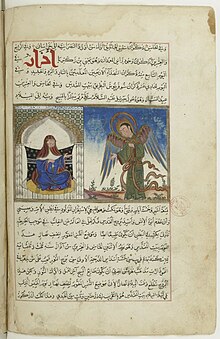 The Annunciation in miniature
The Annunciation in miniature
The angel declares the son is to be named Jesus, the Messiah, proclaiming he will be called a great prophet, and is the Spirit of God and Word of God, who will receive al-Injīl (Arabic for the gospel). The angel tells Mary that Jesus will speak in infancy, and when mature, will be a companion to the most righteous. Mary, asking how she could conceive and have a child when no man had touched her, was answered by the angel that God can decree what He wills, and it shall come to pass.[24]
The conception of Jesus as described by Ibn Arabi (d. 1240), an Andalusian scholar, Sufi mystic, poet and philosopher, in the Bezels of Wisdom:
From the water of Mary or from the breath of Gabriel,In the form of a mortal fashioned of clay,
The Spirit came into existence in an essencePurged of Nature's taint, which is called Sijjin (prison)
Because of this, his sojourn was prolonged,Enduring, by decree, more than a thousand years.
A spirit from none other than God,So that he might raise the dead and bring forth birds from clay.[25]
 Pseudo-Arabic on the Christ Child's blanket, Gentile da Fabriano
Pseudo-Arabic on the Christ Child's blanket, Gentile da Fabriano
The narrative from the Quran continues with Mary, overcome by the pains of childbirth, being provided a stream of water under her feet from which she could drink and a palm tree which she could shake so ripe dates would fall and be enjoyed. After giving birth, Mary carries baby Jesus back to the temple and she is asked by the temple elders about the child. Having been commanded by Gabriel to a vow of silence, she points to the infant Jesus and the infant proclaims:
He said, I am God's servant; He has given me the Book, and made me a prophet. He has made me blessed wherever I am, and has enjoined on me the Worship and Alms, so long as I live; and to be dutiful to my mother; and has not made me oppressive, impious. Peace is on me the day I was born, the day I shall die, and the day I shall be raised alive.[26]
Jesus speaking from the cradle is one of six miracles attributed to him in the Quran.[27] The speaking infant theme is also found in the Syriac Infancy Gospel, a pre-Islamic sixth-century work.[28]
Birth narratives
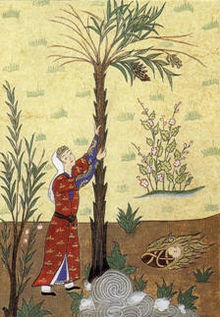
According to the Quran, the pains of labor took Mary to the trunk of a palm tree.
The Islamic faith echoed some strands within the Christian tradition that Mary (or Maryam) was a literal virgin when Jesus was conceived. The most detailed account of the annunciation and birth of Jesus is provided in Surah 3 (Al Imran) and 19 (Maryam) of the Quran where the story is narrated that God (Allah) sent an angel to announce that Maryam could shortly expect to bear a son, despite being a virgin.[29]
Some academics have noted that the account in Surah 19[30] is particularly close to that in the Christian Gospel of Luke.[31] The Annunciation to Mary is mentioned twice in the Quran and in both instances Mary/ Maryam is told that she was chosen by God to deliver a son. In the first instance, the bearer of the news (who is believed by most Muslims to be the archangel Gabriel), delivered the news in (3:42-47) as he takes the form of a man (19:16-22).[32][33] The details of the conception are not discussed but when Mary asks how she can bear a son in view of her chastity she is told that God creates what he wills and that these things are easy for God.[32][34] The Quran (21:91 and 66:12) says that God blew through his angel into Mary and she, although being chaste bore Jesus without any father.[35][36]
Ibn Ishaq (d. 761 or 767), an Arab historian and hagiographer, wrote the account entitled Kitab al-Mubtada (In the Beginning), reporting that Zechariah is Mary's guardian briefly, and after being incapable of maintaining her, he entrusts her to a carpenter named George. Secluded in a church, she is joined by a young man named Joseph, and they help one another fetching water and other tasks. The account of the birth of Jesus follows the Quran's narrative, adding that the birth occurred in Bethlehem beside a palm tree with a manger.[37]
Al-Tabari (d. 923), a Persian scholar and historian, contributed to the Jesus birth narrative by mentioning envoys arriving from the king of Persia with gifts (similar to the Magi from the east) for the Messiah; the command to a man called Joseph (not specifically Mary's husband) to take her and the child to Egypt and later return to Nazareth.[38]
Al-Masudi (d. 956), an Arab historian and geographer, reports in his work The Meadows of Gold Jesus being born at Bethlehem on Wednesday 24 December (a detail likely received from contemporary Christians) without mentioning the Quranic palm tree.[38]
Ali ibn al-Athir (d. 1233), an Arab or Kurdish historian and biographer, reported in The Perfection of History (al-Kamil), a work which became a standard for later Muslims, that Joseph the carpenter had a more prominent role, but is not mentioned as a relative or husband of Mary. Al-Athir writes about how Jesus as a young boy helped to detect a thief and bringing a boy back to life which Jesus was accused of having killed. That work mentions a version of the birth narrative having taken place in Egypt without mention of a manger under the palm tree, but adds that the first version of the birth in the land of Mary's people is more accurate. Al-Athir makes a point believing Mary's pregnancy to have lasted not nine or eight months, but only a single hour. His basis is that this understanding is closer to where the Quran says Mary 'conceived him and retired with him to a distant place' (Maryam (19) 22).[39]
Childhood
Main article: Finding in the Temple
See also: Flight into Egypt and Infancy Gospel of Thomas
The Quran does not include the tradition of the Flight into Egypt, though sūra XXIII, 50 could conceivably allude to it: “And we made the son of Maryam and his mother a sign; and we made them abide in an elevated place, full of quiet and watered with springs”.[40] However, narratives similar to the narrative found in the Gospels and non-canonical sources circulated in later Islamic tradition, with some details and elaborations being added over the centuries by Islamic writers and historians. Some narratives have Jesus and family staying in Egypt up to 12 years.[41] Many moral stories and miraculous events of Jesus' youth are mentioned in Qisas al-anbiya (Stories of the Prophets), books composed over the centuries about pre-Islamic prophets and heroes.[42]
Al-Masudi wrote that Jesus as a boy studied the Jewish religion reading from the Psalms and found "traced in characters of light":
You are my son and my beloved; I have chosen you for myselfwith Jesus then claiming:
"today the word of God is fulfilled in the son of man".[43]
In Egypt
See also: Infancy Gospel of Thomas
Several narratives show some disparity and similarity in Islamic writings about Jesus' early childhood, specifically his time in Egypt with regard to duration and events. Most of the narratives are found in non-canonical Christian sources like, for example, the pre-Islamic Gospel of Thomas. One such disparity is from al-Athir in his The Perfection of History which contains a birth narrative stating Jesus was born in Egypt instead of Bethlehem.[39]
Some other narratives of Jesus' childhood are popular Middle Eastern lore as highlighted by professor of interfaith studies Mahmoud M. Ayoub.[44] Many miracles are attributed to a young Jesus while in Egypt.[18] (see "Miracles" and "Other miracles" section)
Adulthood
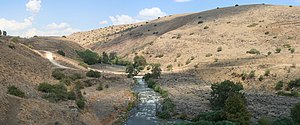
The Jordan River, where Jesus was baptized by Yahya ibn Zakariyya (John the Baptist).[45]
Mission
See also: Ministry of Jesus and Apostle (Islam)
It is generally agreed that Jesus spoke Aramaic, the common language of Judea in the first century A.D. and the region at-large.[46]
The first and earliest view of Jesus formulated in Islamic thought is that of a prophet — a human being chosen by God to present both a judgment upon humanity for worshipping idols and a challenge to turn to the one true God. From this basis, reflected upon all previous prophets through the lens of Muslim identity, Jesus is considered no more than a messenger repeating a repetitive message of the ages. Jesus is not traditionally perceived as divine, yet Muslim ideology is careful not to view Jesus as less than this, for in doing so would be sacrilegious and similar to rejecting a recognized Islamic prophet.[citation needed] The miracles of Jesus and the Quranic titles attributed to Jesus demonstrate the power of God rather than the divinity of Jesus — the same power behind the message of all prophets. Some Islamic traditions believe Jesus' mission was only to the people of Israel and his status as a prophet being confirmed by numerous miracles.[47][48]
A second early high image of Jesus is an end-time figure. This concept arises mostly from the Hadith. Muslim tradition constructs a narrative similarly found in Christian theology, seeing Jesus arriving at the end of time and descending upon earth to fight the Antichrist. This narrative is understood to champion the cause of Islam, with some traditions narrating Jesus pointing to the primacy of Muhammad. Most traditions state Jesus will then die a natural death.[49]
A third and distinctive image is of Jesus representing an ascetic figure — a prophet of the heart. Although the Quran refers to the ‘gospel’ of Jesus, those specific teachings of his are not mentioned in the Quran or later religious texts. They are largely absent. The Sufi tradition is where Jesus became revered, acknowledged as a spiritual teacher with a distinctive voice from other prophets, including Muhammad. Sufism tends to explore the dimensions of union with God through many approaches, including asceticism, poetry, philosophy, speculative suggestion, and mystical methods. Although Sufism to the Western mind may seem to share similar origins or elements of Neoplatonism, Gnosticism, and Buddhism, the ideology is distinctly Islamic since they adhere to the words of the Quran and pursue imitation of Muhammad as the perfect man.[50]
Preaching
The Islamic concepts of Jesus' preaching is believed to have originated in Kufa, Iraq, under the Rashidun Caliphate where the earliest writers of Muslim tradition and scholarship was formulated. The concepts of Jesus and his preaching ministry developed in Kufa was adopted from the early ascetic Christians of Egypt who opposed official church bishopric appointments from Rome.[51]
The earliest stories, numbering about 85, are found in two major collections of ascetic literature entitled Kitab al-Zuhd wa'l Raqa'iq (The Book of the Asceticism and Tender Mercies) by Ibn al-Mubarak (d. 797), and Kitab al-Zuhd (The Book of Asceticism) by Ibn Hanbal (d. 855). These sayings fall into four basic groups: a) eschatological sayings; b) quasi-Gospel sayings; c) ascetic sayings and stories; d) sayings echoing intra-Muslim polemics.[52]
The first group of sayings expands Jesus' archetype as portrayed in the Quran. The second group of stories, although containing a Gospel core, are expanded with a "distinctly Islamic stamp". The third group, being the largest of the four, portrays Jesus as a patron saint of Muslim asceticism. The last group builds upon the Islamic archetype and Muslim-centric definition of Jesus and his attributes, furthering esoteric ideas regarding terms such as "Spirit of God" and "Word of God".[53]
Miracles
Main article: Miracles of Jesus
See also: Infancy Gospel of Thomas
At least six miracles are attributed to Jesus in the Quran, with many more being added over the centuries by writers and historians. Miracles were attributed to Jesus as signs of his prophethood and his authority, according to educator and professor Ishaq Musa Al-Husayni (d. 1990), an author most known for Mudhakkirat Dajaja (Memoirs of a Hen) (Cairo: Dar al-Maarif, 1943; 2nd ed. 1967). In Christ in the Quran and in Modern Arabic Literature (1960), Al-Husayni said it is noteworthy Muhammad attributes no miracles to himself.[54]
These six miracles in the Quran are without detail unlike the Gospel and their non-canonical sources, which include details and mention other attributed miracles.[54] Over the centuries, these six miracle narratives have been elaborated through Hadith and poetry, with religious writings including some of the other miracles mentioned in the Gospel, non-canonical sources, and from lore.[18][44]
Speaking from the cradle
Speaking from the cradle is mentioned in three places in the Quran: al-Imran (3) 41, 46, al-Maida (5) 109-110 and Maryam (19) 29-30. Part of the narrative has the infant Jesus defending his mother Mary from the accusation of having given birth without a known husband.[55] Early Islam was unclear about Joseph and his role. Jesus speaks as the angel Gabriel had mentioned at the annunciation: Jesus proclaims he is a servant of God, has been given a book, is a prophet, is blessed wherever he will go, blesses the day he was born, the day he will die, and the day he is raised alive.[56]
Although this particular narrative is not found in the Bible, the theme of speaking from the cradle is found in the non-canonical pre-Islamic Syriac Infancy Gospel. That source has Jesus declaring himself the Son of God, the Word, and affirming what the angel Gabriel had previously announced to Mary as detailed in the Gospel.[55]
Creating birds from clay
The miracle of creating birds from clay and breathing life into them when a child is mentioned in al-Imran (3) 43, 49 and al-Maida (5) 109-110. Although this miracle is also not mentioned the canonical Gospel, the same narrative is found in at least two pre-Islamic sources: the Infancy Gospel of Thomas and the Jewish Toledot Yeshu, with few variant details between the Quran and these two sources.[57][58]
Healing the blind and the leper[edit]
See also: Healing the two blind men in Galilee and Cleansing ten lepers
Similar to the New Testament, the Quran mentions Jesus healing the blind and the lepers in al-Imran (3) 49. Muslim scholar and judge al-Baydawi (d. 1286) wrote how it was recorded that many thousands of people came to Jesus to be healed, and that Jesus healed these diseases through prayer only.[59] Medieval scholar al-Tha`labi wrote about how these two particular diseases were beyond medical help, and Jesus' miracles were meant to be witnessed by others as clear signs of his message.[57]
Power over death
Jesus is believed to have raised people from the dead, as mentioned in al-Imran (3) 49. Although no detail is given as to who was raised or the circumstance, at least three people are mentioned in detail in the Gospel (a daughter of Jairus, a widow's son at Nain, and Lazarus).[60]
Prescience
Jesus was able to predict, or had foreknowledge,[61] of what was hidden or unknown to others. One example is Jesus would answer correctly any and every question anyone asked him. Another example is Jesus knew what people had just eaten, as well as what they had stored in their homes.[18]
Table of food from heaven[edit]
Main article: Feeding the multitude
See also: Last Supper
In the fifth chapter of the Quran, al-Maida (5) 112-115, a narration mentions the disciples of Jesus requesting a table laden with food, and for it to be a special day of commemoration for them in the future. This may be a possible reference to the Eucharist according to professor of Islamic and Arabic studies W. Montgomery Watt (d. 2006).[62] According to professor of comparative religions Geoffrey Parrinder (d. 2005), it is unclear if this story parallels the Gospel's Last Supper or the feeding the multitude, but may be tied to the Arabic word ʿīd (Muslim festival):[63]
"One time the disciples said, O Jesus, son of Mary, can your Lord send down for us a table from heaven? He said, Fear God, if you are believers. They said, We want to eat of it, and that our hearts may be at peace, and we may know you have spoken truthfully and be among the witnesses to it. Jesus, son of Mary, said, O God our Lord send down upon us a table from heaven, to be for us a festival, for the first of us and the last of us, and a sign from you: and give provision (of food) to us, for you are the best of providers. God said, I am sending it down for you."[62]
In a record by the Sunni exegete Tabari, before the last supper, the threat death of anxious him. Therefore, Jesus invited his disciples for a last supper. After the meal, he washed their hands and performed their ablutions to wipe their hands on his clothing. Afterwards Jesus replied to them: "As for that I have done to you tonight, in that I served you the meal and washed your hands in person, let it be an example for you. Since you indeed consider me to be better than you, do not be haughty in relation to each other but rather expand yourselve for each other as I have expanded myself for you." After instructing the disciples in his teachings, Jesus foretells that one of them would deny him and another betray him. However, in accordance with Islamic denial of crucifixion, just a corpse in semblance of Jesus was caught and crucified and Jesus himself was raised to God.[64]
Other miracles
Many stories and narratives have been developed over the years about Jesus, containing certain inherent lessons or providing meaning due to the lack of detail in the Quran regarding Jesus. Some of these narratives are similar in nature to the New Testament, while some portray Jesus in a very human manner.
Besides some detail summaries of miracles of Jesus mentioned by Muslim writers over the centuries, from adulthood (like walking on water - also found in the Gospel - and causing loaves of bread to come from the ground),[55] some other miracles from childhood include: explaining the Muslim creed fundamentals to a schoolmaster, revealing who the thieves were to a wealthy chief, filling empty jars of something to drink, providing food and wine for a tyrannical king while also proving to this king his power in raising a dead man from the dead, raising a child accidentally killed, and causing the garments from a single-colored vat to come out with various colors.[18]
Healing a royal official's son
Main article: Healing the royal official's son
Al-Tabari (d. 923) reports a story of an adult Jesus' encounter with a certain king in the region and the healing of his son. The identity of the king is not mentioned while legend suggests Philip the Tetrarch. The corresponding Bible reference is "the royal official's son."[65]
Greed and truth-telling
A legendary story of a miracle by a young Jesus, used as a hard-learned lesson popularly found in Middle Eastern lore according to professor Ayoub, has to do with a Jewish man and loafs of bread. Although carrying a polemic tone, the lesson centers on greed with truth-telling weaved into the narration. It is a story found often in children's books.[66]
Inherent wisdom
See also: Logos (Islam) and Logos (Christianity)
Another legendary miracle story is one regarding Jesus' childhood wisdom. This legend, reported through al-Tabari from ibn Ishaq, talks about Mary sending Jesus to a religious school and the teacher being astonished to find Jesus already knowing the information being taught / discussed.[18]
Food in children's homes
Another story from al-Tabari tells of a young Jesus playing with the youths of his village and telling them what food their parents were preparing for them at home.[18]
According to the details of the narrative, some parents became annoyed and forbade their children to play with Jesus, suspecting he was a magician. As a result, the parents kept their children away from Jesus and gathered their children into a single house. One day, feeling lonely, Jesus went out looking for his friends, and coming upon this house he asked the parents where their children were. The parents responded that the children were not there [lied]. After Jesus asks who, then, is in the house, the parents call Jesus a pig. Jesus then says 'let there be swine in this house' which turns all the children into swine.[67]
Scripture
Main article: Gospel in Islam
See also: Ministry of Jesus
Muslims believe that God revealed to Jesus a new scripture, al-Injīl (the Gospel), while also declaring the truth of the previous revelations: al-Tawrat (the Torah) and al-Zabur (the Psalms). The Quran speaks favorably of al-Injīl, which it describes as a scripture that fills the hearts of its followers with meekness and piety. Traditional Islamic exegesis claiming the biblical message to have been distorted or corrupted (tahrif), is termed ta'yin al-mubham ("resolution of ambiguity").[68] This polemic effort has its origins in the medieval period with Abd al-Jabbar ibn Ahmad's writings.[69]
Regarding the Law of Moses, the Quran indicates that Jesus never abolished Jewish laws but rather confirmed them, while making partial abrogations only.[70]
Islam rejects Paul's theology of justification before God by faith alone as held by some Protestants or faith through grace as held by Catholics, Orthodox and most mainline Protestants. Jesus' legal perspective did not involve a New Covenant concerning works,[citation needed] but to simply modify those existing laws.[citation needed] Shabir Ally considers this understanding to corroborate with the canonical gospels that include Matthew 5:17.[citation needed]
According to Yusuf al-Qaradawi in his book The Lawful and the Prohibited in Islam, the legal restrictions Jesus abrogated for Jews where those initially legislated by God as a punishment.[71] Classical commentaries such as Tafsir al-Jalalayn specify they pertained to the consumption of fish and bird meat without spikes, or in general.[72]
Disciples
The Quran states that Jesus was aided by a group of disciples who believed in His message. While not naming the disciples, the Quran does give a few instances of Jesus preaching the message to them. According to Christianity, the names of the twelve disciples were Peter, Andrew, James, John, Philip, Bartholomew, Thomas, Matthew, James, Jude, Simon and Judas.
The Quran mentions in chapter 3, verses 52-53, that the disciples submitted to the faith of Islam:[non-primary source needed]
When Jesus found Unbelief on their part He said: "Who will be My helpers to (the work of) Allah?" Said the disciples: "We are Allah's helpers: We believe in Allah, and do thou bear witness that we are Muslims.
Our Lord! we believe in what Thou hast revealed, and we follow the Messenger; then write us down among those who bear witness."
— Quran Surah Al-Imran 52-53[73]
The longest narrative involving Jesus' disciples is when Jesus performs the miracle of bringing a table of food from heaven at their request, for further proof that his preaching is the true message.
Death
Main article: Islamic view of Jesus' death
Most Islamic traditions, save for a few, categorically deny that Jesus physically died, either on a cross or another manner. The contention is found within the Islamic traditions themselves, with the earliest Hadith reports quoting the companions of Muhammad stating Jesus having died, while the majority of subsequent Hadith and Tafsir argue in favor of the denial through exegesis and apologetics, becoming the popular (orthodox) view.
Professor and scholar Mahmoud M. Ayoub sums up what the Quran states despite interpretative arguments:
"The Quran, as we have already argued, does not deny the death of Christ. Rather, it challenges human beings who in their folly have deluded themselves into believing that they would vanquish the divine Word, Jesus Christ the Messenger of God. The death of Jesus is asserted several times and in various contexts." (3:55; 5:117; 19:33.)[74]
Some disagreement and discord can be seen beginning with Ibn Ishaq's (d. 761) report of a brief accounting of events leading up to the crucifixion, firstly stating that Jesus was replaced by someone named Sergius, while secondly reporting an account of Jesus' tomb being located at Medina and thirdly citing the places in the Quran (3:55; 4:158) that God took Jesus up to himself.[75]
An early interpretation of verse 3:55 (specifically "I will cause you to die and raise you to myself"), Al-Tabari (d. 923) records an interpretation attributed to Ibn 'Abbas, who used the literal "I will cause you to die" (mumayyitu-ka) in place of the metaphorical mutawaffi-ka "Jesus died", while Wahb ibn Munabbih, an early Jewish convert, is reported to have said "God caused Jesus, son of Mary, to die for three hours during the day, then took him up to himself." Tabari further transmits from Ibn Ishaq: "God caused Jesus to die for seven hours",[76] while at another place reported that a person called Sergius was crucified in place of Jesus. Ibn-al-Athir forwarded the report that it was Judas, the betrayer, while also mentioning the possibility it was a man named Natlianus.[77]
Al-Masudi (d. 956) reported the death of Christ under Tiberius.[77]
Ibn Kathir (d. 1373) follows traditions which suggest that a crucifixion did occur, but not with Jesus.[78] After the event, Ibn Kathir reports the people were divided into three groups following three different narratives; The Jacobites believing ‘God remained with us as long as He willed and then He ascended to Heaven;’ The Nestorians believing ‘The son of God was with us as long as he willed until God raised him to heaven;’ and the Muslims believing; ‘The servant and messenger of God, Jesus, remained with us as long as God willed until God raised him to Himself.’[79]
Another report from Ibn Kathir quotes Ishaq Ibn Bishr, on authority of Idris, on authority of Wahb ibn Munabbih, that "God caused him to die for three days, then resurrected him, then raised him."[80][81]
Michael Cook notes that denial that Jesus died follows the Christian heresy of Docetism, who were "disturbed by that God should have died", but that this concern conflicts with another Islamic doctrine, that Jesus was a man not God.[82] Quranic commentators seem to have concluded the denial of the crucifixion of Jesus by following material interpreted in Tafsir that relied upon extra-biblical Judeo-Christian sources,[83] with the earliest textual evidence having originated from a non-Muslim source; a misreading of the Christian writings of John of Damascus regarding the literal understandings of Docetism (exegetical doctrine describing spiritual and physical realities of Jesus as understood by men in logical terms) as opposed to their figurative explanations.[84] John of Damascus highlighted the Quran's assertion that the Jews did not crucify Jesus being very different from saying that Jesus was not crucified, explaining that it is the varied Quranic exegetes in Tafsir, and not the Quran itself, that denies the crucifixion, further stating that the message in the 4:157 verse simply affirms the historicity of the event.[85]
Ja’far ibn Mansur al-Yaman (d. 958), Abu Hatim Ahmad ibn Hamdan al-Razi (d. 935), Abu Yaqub al-Sijistani (d. 971), Mu'ayyad fi'l-Din al-Shirazi (d. 1078) and the group Ikhwan al-Safa also affirm the historicity of the Crucifixion, reporting Jesus was crucified and not substituted by another man as maintained by many other popular Quranic commentators and Tafsir.
In reference to the Quranic quote "We have surely killed Jesus the Christ, son of Mary, the apostle of God", Muslim scholar Mahmoud Ayoub asserts this boast not as the repeating of a historical lie or the perpetuating of a false report, but an example of human arrogance and folly with an attitude of contempt towards God and His messenger(s). Ayoub furthers what modern scholars of Islam interpret regarding the historical death of Jesus, the man, as man's inability to kill off God's Word and the Spirit of God, which the Quran testifies were embodied in Jesus Christ. Ayoub continues highlighting the denial of the killing of Jesus as God denying men such power to vanquish and destroy the divine Word. The words, "they did not kill him, nor did they crucify him" speaks to the profound events of ephemeral human history, exposing mankind's heart and conscience towards God's will. The claim of humanity to have this power against God is illusory. "They did not slay him...but it seemed so to them" speaks to the imaginations of mankind, not the denial of the actual event of Jesus dying physically on the cross.[86]
Islamic reformer Muhammad Rashid Rida agrees with contemporary commentators interpreting the physical killing of Christ's apostleship as a metaphorical interpretation.[87]
SubstitutioN
It is unclear exactly where the substitutionist interpretation originated, but some scholars consider the theory originating among certain Gnostic groups of the second century.[28]
Leirvik finds the Quran and Hadith to have been clearly influenced by the non-canonical ('heretical') Christianity that prevailed in the Arab peninsula and further in Abyssinia.[88]
Muslim commentators have been unable to convincingly disprove the crucifixion. Rather, the problem has been compounded by adding the conclusion of their substitutionist theories. The problem has been one of understanding.[89]
"If the substitutionist interpretation (Christ replaced on the cross) is taken as a valid reading of the Qur'anic text, the question arises of whether this idea is represented in Christian sources. According to Irenaeus' Adversus Haereses, the Egyptian Gnostic Christian Basilides (2nd century) held the view that Christ (the divine nous, intelligence) was not crucified, but was replaced by Simon of Cyrene. However, both Clement of Alexandria and Hippolytus denied that Basilides held this view. But the substitutionist idea in general form is quite clearly expressed in the Gnostic Nag Hammadi documents Apocalypse of Peter and The Second Treatise of the Great Seth."[75]
While most Western scholars,[90] Jews,[91] and Christians believe Jesus died, orthodox Muslim theology teaches he ascended to Heaven without being put on the cross and God transformed another person, Simon of Cyrene, to appear exactly like Jesus who was crucified instead of Jesus (cf. Irenaeus' description of the heresy of Basilides, Book I, ch. XXIV, 4.).[92]
Ascension
Main article: Islamic view of Jesus' death
Modern Islamic scholars like Sayyid Muhammad Husayn Tabataba'i interpret the ascension of Jesus as spiritual, not physical. This interpretation is in accord with Muʿtazila and Shia metaphorical explanations regarding anthropomorphic references to God in the Quran. Although not popular with traditional Sunni interpretations of the depiction of crucifixion, there has been much speculation and discussion in the effort of logically reconciling this topic.[93]
In ascetic Shia writings, Jesus is depicted having "ascended to heaven wearing a woolen shirt, spun and sewed by Mary, his mother. As he reached the heavenly regions, he was addressed, “O Jesus, cast away from you the adornment of the world."[94]
Second coming
See also: Second Coming § Islam, Islamic eschatology, and Hadith of Jesus Praying Behind Mahdi
According to Islamic tradition which describes this graphically, Jesus' descent will be in the midst of wars fought by al-Mahdi (lit. "the rightly guided one"), known in Islamic eschatology as the redeemer of Islam, against al-Masih ad-Dajjal (the Antichrist "false messiah") and his followers.[95] Jesus will descend at the point of a white arcade, east of Damascus, dressed in yellow robes—his head anointed. He will say prayer behind al-Mahdi then join him in his war against the Dajjal. Jesus, considered as a Muslim, will abide by the Islamic teachings. Eventually, Jesus will slay the Antichrist, and then everyone who is one of the People of the Book (ahl al-kitāb, referring to Jews and Christians) will believe in him. Thus, there will be one community, that of Islam.[96][97][98]
Sahih al-Bukhari, Volume 3, Book 43: Kitab-ul-`Ilm (Book of Knowledge), Hâdith Number 656:
Allah's Apostle said, "The Hour will not be established until the son of Mary (i.e. Jesus) descends amongst you as a just ruler, he will break the cross, kill the pigs, and abolish the Jizya tax. Money will be in abundance so that nobody will accept it (as charitable gifts)."
— Narrated by Abu Huraira[99][100]
After the death of al-Mahdi, Jesus will assume leadership. This is a time associated in Islamic narrative with universal peace and justice. Islamic texts also allude to the appearance of Ya'juj and Ma'juj (known also as Gog and Magog), ancient tribes which will disperse and cause disturbance on earth. God, in response to Jesus' prayers, will kill them by sending a type of worm in the napes of their necks, and send large birds to carry and clear their corpses from the land.[95] Jesus' rule is said to be around forty years, after which he will die. Muslims will then perform the funeral prayer for him and then bury him in the city of Medina in a grave left vacant beside Muhammad, Abu Bakr, and Umar (companions of Muhammad and the first and second Sunni caliphs (Rashidun) respectively.[101]#fastitinks.com









